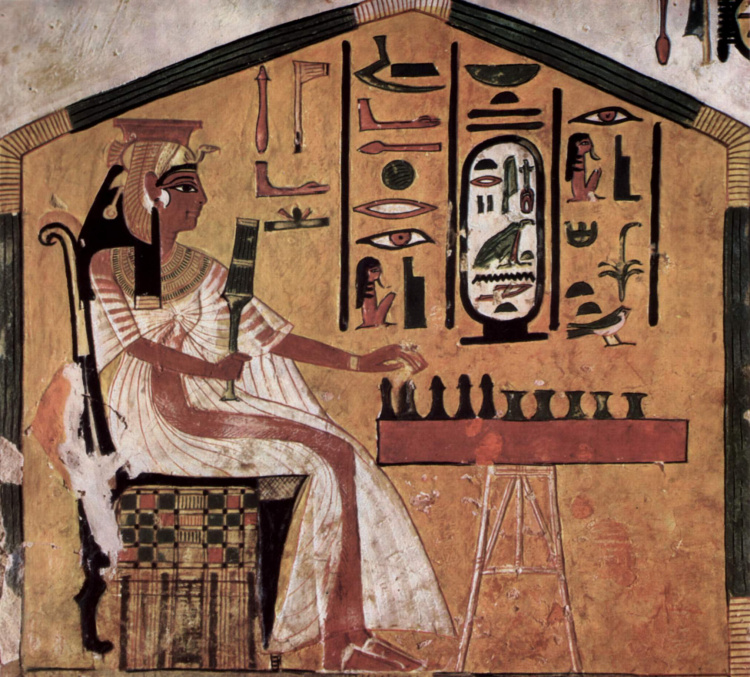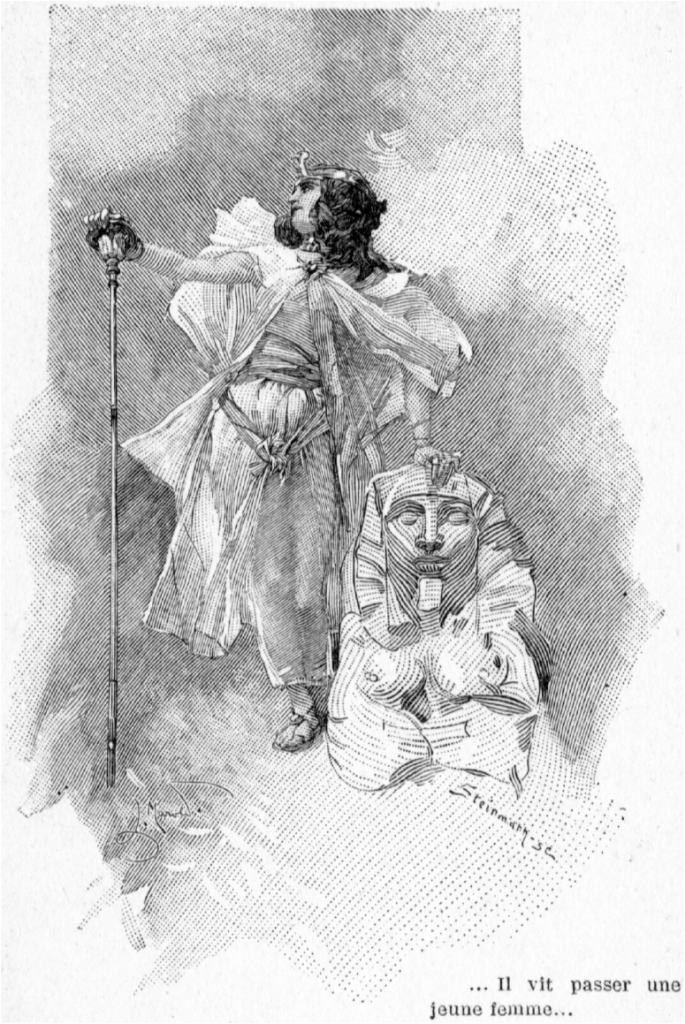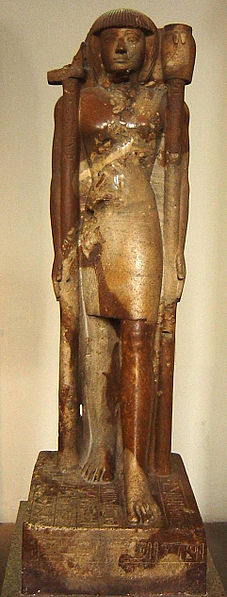I went down a rabbit hole yesterday morning that—after some exciting twists and turns—led me back to an older blog post here on Isiopolis. And I realized that I hadn’t finished the story of Ahwere, Naneferkaptah, and their child, Merib.
This story has been called the pinnacle of ancient Egyptian literature (though we don’t have that much ancient Egyptian literature). It was written down in the Ptolemaic period and is usually called Setne and the Magic Book. It’s a classic type of ancient tale and involves Isis, Thoth, and dead Egyptians having effect in the living world. In it, the son of Rameses the Great, Setne Kaemweset, learns that a previous prince, Naneferkaptah, had acquired vast magical knowledge and an amazing magical book locked inside a series of chests and sunk in the bottom of the river. Now, the son of Rameses, also a glutton for magical knowledge, wants it for himself. (The real Kaemweset became a Sem-Priest of Ptah at Memphis and was responsible for new buildings at the temple of Ptah as well as restorations of ancient tombs and pyramids. He became a kind of folk hero with fantastical tales attached to his name.)
If you don’t remember it, you might want to reread the first part of the tale here before going into this next part. Now on with the tale..
I’m going to back up a just a bit to tell you a little more about the contests between Setne and Naneferkaptah over the magic book. Remember, Setne wants its magical power and Naneferkaptah, who is deceased, wants to keep it hidden because of the great tragedies that befall anyone who uses the book.
So Ahwere and Naneferkaptah, wife and husband, are in Naneferkaptah’s tomb warning Setne not to lust after this dangerous book. Setne threatens to take it by force if they don’t hand it over to him. So Naneferkaptah says he can only get the book by being able to best Naneferkaptah at a game a droughts (perhaps the game of Senet, the equipment for which was found in a number of tombs). Setne is up for the challenge. But Naneferkaptah wins the first game. By his magic, Naneferkaptah sinks Setne into the earth up to his lower legs. After losing the second game, Setne is sunk to his crotch, and on losing the third, he is sunk to his ears. Setne was down, but not out. He gives Naneferkaptah a whack and sends the spirit of his deceased brother to Setne’s father, the pharaoh, to tell of everything that happened and ask for help. This the spirit does—and pharaoh sends some powerful magic to Setne.
A few formidable amulets later, Setne is out of the earth, has snatched the magical book from Ahwere and Naneferkaptah, and runs out of the tomb. As he goes, Ahwere laments that all power has left the tomb. But Naneferkaptah comforts her and vows to make him return the book.
Setne locks the tomb behind him and goes to his father. Dad advises Setne to be smart and put the dang book back, but Setne refuses. In fact, like an idiot, he proceeds to read the magic book to everyone. (The story doesn’t tell us how this came out.)
Now we have a change of scene. Sometime after Setne gets the book, he finds himself walking in the temple of Ptah and sees an incredibly beautiful and alluring woman there, too. He cannot take his eyes off her and has his servant go find out who she is. Turns out she is the daughter of the High Priest of Bastet and her name is Tabubu. Setne, prince that he is, somehow thinks it would be a good idea to send his servant to offer her 10 pieces of gold to spend a hour with him. Not only that, but his invitation includes a veiled threat demanding her compliance. She is insulted and highly pissed.
So, she sends word to Setne that if he wants to do as he wishes with her, he has to come to her house, she being of priestly rank. Setne was okay with that, but everyone around him thought it was a Very Bad Idea.
So off to Bubastis he goes and he finds that Tabubu lives in a very rich house upon very rich grounds. Tabubu greets him and has him come inside with her. She serves him food and drink and they fool around for a while. Finally, Setne is ready to do the deed. Ah no, says Tabubu. She is of priestly rank and if he wants her he must sign over all his possessions. Somehow, Setne thinks this is a good idea and has a legal paper drawn up and signs it. Then Tabubu tells him that his children are here. Setne says to bring them to him. As Tabubu stands to go get the children, the transparent gown she is wearing makes Setne ever hotter and he begs to have sex with her. Nope, she says, not until your children sign off on the paperwork you just signed. Which they do. He begs again. Nope. Not until your children are killed. Setne—clearly madder than a hatter by this time—agrees. Their bodies are thrown out the window to be devoured by cats and dogs. Yeesh.
Finally, Tabubu leads him to a couch. They lay down together and just as he reaches out to touch her…
He wakes up with a huge erection and nothing to do with it.
Then he realizes that it was Naneferkaptah who sent him this evil dream (perhaps to show him how much of a monster could be?). When Setne goes out into the street, still naked, he comes upon the pharaoh. I am imagining the pharaoh rolling his eyes to the heavens as he advises his wayward son to go to Memphis and see his children, who are indeed alive. Pharaoh again advises Setne to get rid of the book. This time Setne listens and takes the book back to the tomb of Naneferkaptah where Naneferkaptah and the ka of Ahwere remain. Now remember that Ahwere and their child Merib are buried in Koptos in the vicinity of the temple of Isis and Harpokrates. She is in Naneferkaptah’s tomb just in ka-form. In order make amends, Naneferkaptah tells Setne go find the tombs of Ahwere and Merib and bring their bodies back to be buried in Memphis with him.
So prince Setne takes pharaoh’s boat and goes to Koptos. He makes offering to Isis and Harpokrates when he arrives. Then Setne and the priests of Isis spend three days searching for Ahwere and Merib, with no success. Meanwhile, Naneferkaptah had been keeping tabs on Setne and has seen his lack of success. So he changes himself into the likeness of an old priest. When Setne sees him, he thinks that such an old man just might remember where they were buried. As the old man was really Naneferkaptah, he most certainly did and told Setne they were under part of the small town of Pehemato (another translation says under the house of the chief of police). Digging there, Ahwere and Merib were found. And the now-reformed prince restores everything that had been destroyed during their digging just as it had been.
Ahwere and Merib’s bodies were taken to Memphis and buried with Naneferkaptah. The family was reunited and Setne learned his lesson. And so our the story is complete and you have now heard one of ancient Egypt’s greatest tales.
And on another note, a blessed and happy Easter to all who celebrate.








